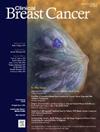Analysis of Factors Associated With Pathological Complete Response in Patients With HER2-Positive Breast Cancer Receiving Neoadjuvant Chemotherapy
IF 2.9
3区 医学
Q2 ONCOLOGY
引用次数: 0
Abstract
Purpose
This study aimed to examine the impact of the level of HER2 overexpression on pathologic and clinical outcomes in HER2-positive breast cancer (BC) patients treated with neoadjuvant therapy (NAT).
Methods
Women with Stage II or III HER2-positive BC who received anthracycline-taxane-trastuzumab NAT regimens followed by curative-intent surgery were included. Patients were classified according to tumor HER2 expression into HER2-high (immunohistochemistry (IHC) 3+ or fluorescence in situ hybridization (FISH) HER2/CEP17 ratio ≥5 or HER2 copy number ≥10) and HER2-intermediate (IHC 2+ with HER2/CEP17 ratio ≥2 to <5 or copy number ≥4 to <10). Univariate and multivariate logistic regression analyses were performed using HER2 expression as a categorical variable. The primary outcome was pathological complete response (pCR). Estimated 3-year disease-free survival (DFS) and Overall Survival (OS) were secondary outcomes.
Results
Among 161 patients with HER2-positive BC, 139 (86%) and 22 (14%) were classified as HER2-high and HER2-intermediate, respectively; 105 (65.2%) had hormone receptor (HR)-positive tumors; 72 (45%) achieved a pCR. In the overall population, pCR rates of 18% and 49% were achieved in HER2-intermediate and HER2-high cases, respectively (odds ratio [OR] = 0.23 95% CI 0.07-0.72; P = .007). No pCRs were observed among HR-positive, HER2-intermediate cases. Estimated 3-year DFS was 97.1% versus 89.3% for patients achieving a pCR versus those with residual disease, respectively (P = .0011).
Conclusion
We found that patients with HER2-high disease were more likely to achieve pCR after NAT compared to patients with HER2-intermediate BC, a subgroup of patients that may benefit from more personalized NAT strategies.
分析接受新辅助化疗的 HER2 阳性乳腺癌患者病理完全缓解的相关因素
目的:本研究旨在探讨HER2过表达水平对接受新辅助治疗(NAT)的HER2阳性乳腺癌(BC)患者的病理和临床结果的影响:方法:纳入接受蒽环类-他烷类-曲妥珠单抗新辅助治疗方案后进行治愈性手术的II期或III期HER2阳性乳腺癌女性患者。根据肿瘤 HER2 表达将患者分为 HER2-高(免疫组化(IHC)3+ 或荧光原位杂交(FISH)HER2/CEP17 比值≥5 或 HER2 拷贝数≥10)和 HER2-中(IHC 2+,HER2/CEP17 比值≥2 至 结果:在161例HER2阳性BC患者中,139例(86%)和22例(14%)分别被归类为HER2-高和HER2-中级;105例(65.2%)为激素受体(HR)阳性肿瘤;72例(45%)获得了pCR。在总体人群中,HER2-中度和HER2-高度病例的pCR率分别为18%和49%(几率比[OR] = 0.23 95% CI 0.07-0.72;P = .007)。在HR阳性、HER2中度病例中未观察到pCR。获得 pCR 的患者和有残留疾病的患者的 3 年 DFS 估计值分别为 97.1% 和 89.3%(P = .0011):我们发现,与 HER2 中度 BC 患者相比,HER2 高的患者在接受 NAT 治疗后更有可能获得 pCR。
本文章由计算机程序翻译,如有差异,请以英文原文为准。
求助全文
约1分钟内获得全文
求助全文
来源期刊

Clinical breast cancer
医学-肿瘤学
CiteScore
5.40
自引率
3.20%
发文量
174
审稿时长
48 days
期刊介绍:
Clinical Breast Cancer is a peer-reviewed bimonthly journal that publishes original articles describing various aspects of clinical and translational research of breast cancer. Clinical Breast Cancer is devoted to articles on detection, diagnosis, prevention, and treatment of breast cancer. The main emphasis is on recent scientific developments in all areas related to breast cancer. Specific areas of interest include clinical research reports from various therapeutic modalities, cancer genetics, drug sensitivity and resistance, novel imaging, tumor genomics, biomarkers, and chemoprevention strategies.
 求助内容:
求助内容: 应助结果提醒方式:
应助结果提醒方式:


